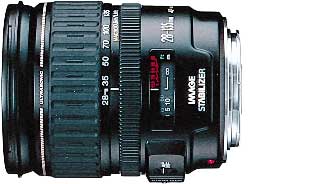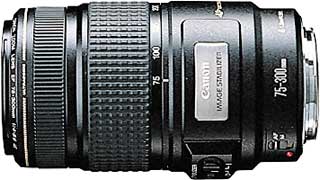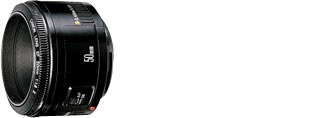
(note from the editor in 2010: This list is outdated and reflects my equipment at around 2001, but I did not have the time to make an update)
As I bought my first SLR nine years ago, it was pure luck that I came home with a Canon body & lens. I just went to the photo shop and asked for a SLR camera with lens. The only cameras I had used until that time were compact cameras.
In the meantime I am shure that I decided right to buy Canon at that time. Canon lenses are really worth their money, and with the exception of some details I am very satisfied with my actual camera. In spring 2001 I got a second body: I was looking for offers at eBay concerning fixed focal length lenses, when I found an offer for an EOS IX, wondering why the seller offered the body for 500 € (the body is listed at Canon with 400 €). To my surprise, a lens for 750 € was included in the offer, but not mentioned in the title of the auction. And 500 € I found ok for the lens, so I got my second EOS body.
Canon's SLR bodies of their actual series are all called "EOS xxx". EOS stands for "electro-optical system", the letters "xxx" stand for a number (and letter combination in case of digital and APS bodies). The smaller this number is, the more "professional" is the body. Bodies for beginners have numbers like the EOS 1000 or 500 (in US named "Rebel"), amateur bodies are named EOS 100, 300 (Rebel 2000 in US) or 50 (Elan II in US). Bodies like the EOS 3, 5 (US A2e), 10 or 30 are designed for the interested amateur. The profi-line mark the various variants of the EOS 1 body, which costs up to 5000 € and above.
Special variants are the digital bodies D2000 and D30, which feature a CCD or CMOS sensor with 2 and 3 million pixels instead of a 35mm film. There exist APS bodies also, named IX and IX 7 (IX lite in the US), which take APS films instead, featuring 3 different formats and magnetic data tracks on the negative/slide.
Since 1993, I am taking pictures with an Canon EOS 5. This is one of the best EOS bodies Canon has made. It is quite robust and has some features cheaper bodies lack: (flash synchronisation time 1/200s, fastes shutter speed 1/8000s, fast AF to mention some). In the actual list of bodies the EOS 30 can be compared to the 5, only the case of the 30 is pure plastic - here the 5 is still more robust.

The EOS IX is one of two bodies for the new APS standard. Because the APS format is some 1/3 smaller than 35mm the manufacturers are able to build tiny cameras. The only disadvantage in this direction is the possibility of using the whole sortiment of Canon's EF lenses for the camera: even the more than 5.000 € "cheap" EF 600mm 1/4.0 L USM fits. At the back of such a lens (16 cm diameter, 45 cm long) it is probably difficult to find the IX. Probably you will tell more than one person that the thing at the back of the tele lens is NOT the cover for the bajonett but the camera...

The IX has a chassis made from stainless steel so it looks a bit more elegant than the rest of the EOS bodies.
The name "IX" comes from the magnetic sensitive layer of the APS films: there "IX" stands for "information exchange", saying that the camera saves data on the negative about date and time of the exposure, aperture, focal length and exposure settings as well as the desired image format. This data is later printed on the back of the paper image, so it is easier to distinguish the changes made for example during several expositions of the same subject.
My lenses are a EF 28-135mm 1/3.5-5.6 IS USM and a EF 75-300mm 1/4-5.6 IS USM as zoom lenses. As standard lenses I own the EF 50mm 1/1.8 II and the EF 100mm 1/2.0 USM.
The EF 28-135mm 1/3.5-5.6 IS USM has a very wide zoom range (nearly a factor of 5 in focal length), but concerning sharpness and contrast it nearly reaches the level of the much more expensive L-class lenses. Distortions are also quit faint, much better as with other lenses in the same zoom range.

But the feature is the image stabilization: you can reach up to exposure time a factor 10 above the magic limit "exposure time in seconds equals inverse focal length in mm" without risking too much shaking blurr.
The lens is a quite good choice for an all-round lens, because it covers a range of focal lenghts which would only be covered by at least three or four prime lenses.
As tele zoom, I use the EF 75-300mm 1/4-5.6 IS USM. It was the first lens from Canon which came with their image stabilisation technique. It price ranges between the amateur lenses and the pro zooms of the "L" class lenses, but its image quality belongs to the amateur class - especially if you consider sharpness wide-open at more than 200mm focal length.

Since the year 2001, I own two lenses with fixed focal lenght. Main reason were some test shots with Fuji Velvia, a high-resolution slide film which is capable of showing more than 80 lines/mm - if the image is sharp enought, which comes from the lens.
If you have once taken an image with a lens of 40 - 50mm focal length, you know that the image is similar to the portion the human eye registers from the same point of view as the camera.

My 50 mm lens is the cheapest EF lens from Canon: The EF 50mm 1/1.8 II. This lens is completely made from plastics, only the lenses are glass and the only piece of metal you see from the outside are the golden contacts of the EF bayonett. But optically it is very sharp.
This lens is very well suited for portraiture. It has a wide opening, allowing to blurr the background even within a short distance to the subject.

It is an EF 100mm 1/2.0 USM, which has a maximum opening of f/2, double the diameter the zoom has at the same focal lenght.
My flash is a Mecablitz 300A from Metz together with an adaptor for Canon EOS (guide number 30 with 35mm focal length, approx. 25 at 28mm).